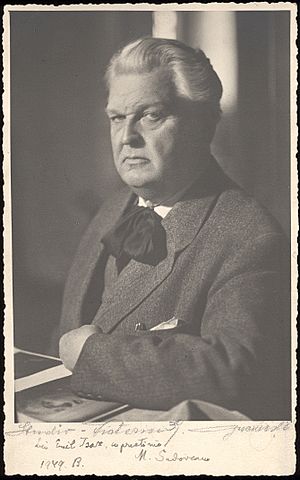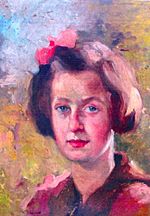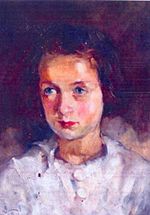Mihail Sadoveanu facts for kids
Quick facts for kids
Mihail Sadoveanu
|
|
|---|---|

1949 photograph
|
|
| Born | November 5, 1880 Pașcani, Iași County, Kingdom of Romania |
| Died | October 19, 1961 (aged 80) Vânători-Neamț, Neamț County, Romanian People's Republic |
| Resting place | Bellu Cemetery, Bucharest, Romania |
| Pen name | Mihai din Pașcani, M. S. Cobuz |
| Occupation | novelist, short story writer, journalist, essayist, translator, poet, civil servant, activist, politician |
| Language | Romanian |
| Nationality | Romanian |
| Genre | historical novel, adventure novel, biographical novel, political novel, psychological novel, crime fiction, memoir, travel literature, nature writing, fantasy, reportage, biography, sketch story, children's literature, lyric poetry |
| Literary movement | Realism, Social realism, Naturalism, Sămănătorul, Poporanism, Socialist realism |
| Years active | 1892 – 1952 |
| Spouses | Ecaterina Bâlu; Valeria Mitru |
| Children |
|
Mihail Sadoveanu (born November 5, 1880 – died October 19, 1961) was a famous Romanian writer, journalist, and political figure. He is known for his many books, especially historical and adventure novels, and his beautiful descriptions of nature.
Sadoveanu's writing career lasted for over 50 years. He was part of different literary groups over time, starting with the traditionalist magazine Sămănătorul. Later, he became known as a Realist writer, focusing on real-life situations. His stories often take place in the historical region of Moldavia and explore themes from Romania's medieval and early modern history. Some of his most famous books include Neamul Șoimăreștilor ("The Șoimărești Family"), Frații Jderi ("The Jderi Brothers"), and Baltagul ("The Hatchet").
After World War II, Sadoveanu became involved with the Romanian Communist Party. He wrote and spoke in favor of the Soviet Union and Stalinism, which was a controversial part of his career. He even served as acting head of state for the communist republic twice.
Sadoveanu was a founding member of the Romanian Writers' Society and later President of the Romanian Writers' Union. He was also a member of the Romanian Academy and received the Lenin Peace Prize. He was the father of Profira and Paul-Mihu Sadoveanu, who also became writers.
Biography
Childhood and Education
Mihail Sadoveanu was born in Pașcani, a town in western Moldavia. His family name, Sadoveanu, came from a village called Sadova. His father, Alexandru Sadoveanu, was a lawyer. His mother, Profira, came from a family of Moldavian shepherds. This mix of backgrounds helped shape his writing.
From 1887, Sadoveanu went to primary school in Pașcani. His favorite teacher, Mr. Busuioc, later inspired one of his well-known short stories, Domnu Trandafir ("Master Trandafir"). When he wasn't in school, young Sadoveanu loved exploring his home region. He enjoyed hunting, fishing, and just watching nature. He also spent holidays in his mother's village, Verșeni. These experiences with peasants shaped his views on society.
He later went to high school in Fălticeni and Iași. Even though he sometimes lost interest in schoolwork, he eventually graduated at the top of his class.
Early Writing and Family Life
Sadoveanu started writing when he was sixteen. In 1897, his first short story, Domnișoara M din Fălticeni ("Miss M from Fălticeni"), was published in a magazine. He also wrote for other journals.
In 1900, Sadoveanu moved to Bucharest to study law, but he soon decided to focus only on writing. He started writing realistic stories instead of poetry. In 1901, he married Ecaterina Bâlu and they settled in Fălticeni. He began writing his first longer stories there, aiming to be a professional writer. His first novel draft, Frații Potcoavă ("The Potcoavă Brothers"), appeared in 1902.
Sadoveanu and his wife had a large family, with eleven children. Three of his daughters, Despina, Teodora, and Profira Sadoveanu, became writers. His son Dimitrie became a painter, and his youngest son, Paul-Mihu, also wrote a novel.
Literary Success and Public Recognition
In 1903, Sadoveanu started writing for Sămănătorul, a traditionalist magazine. He also contributed to Viața Românească, a magazine with a more left-wing view. Both magazines were important for Romanian literature.
1904 was a big year for Sadoveanu. He published four books, including Șoimii ("The Hawks") and Povestiri ("Stories"). A famous critic, Titu Maiorescu, praised Povestiri and helped it win an award from the Romanian Academy. Maiorescu even called Sadoveanu one of Romania's greatest writers.
Sadoveanu continued to publish many books. He also worked as a civil servant for the Ministry of Education. In 1908, he became president of the Romanian Writers' Society. In 1910, he was appointed head of the National Theater Iași.
During the Second Balkan War in 1913, Sadoveanu served in the army as a Lieutenant. He later returned to writing and published Neamul Șoimăreștilor in 1915. During World War I, he stayed in Moldavia and edited a propaganda newspaper.
Joining the Romanian Academy and Political Life
In 1921, Sadoveanu became a full member of the Romanian Academy. His house became a meeting place for many writers and artists. He traveled often, visiting places that inspired his stories, like the Agapia and Văratec monasteries.
His popularity grew even more in the late 1920s and early 1930s with novels like Venea o moară pe Siret... (1925), Zodia Cancerului (1929), and Baltagul (1930). His 50th birthday was celebrated across the country.
In 1926, Sadoveanu entered politics, joining the People's Party. He served in the Parliament and was even President of the Senate. He also wrote for leftist newspapers. Around this time, he became a member of the Freemasonry and later became its Grand Master in Romania.
World War II and Communist Era
In the 1930s, Sadoveanu faced strong criticism from far-right and fascist groups. They attacked him in the press and even burned his books in public. Many other writers and public figures supported him against these attacks.
During World War II, Sadoveanu mostly stayed out of politics. He published the final part of his historical novel Frații Jderi in 1942. He also married Valeria Mitru, a much younger journalist. Sadly, his son Paul-Mihu was killed in action in 1944.
After the war, when the communist system took over Romania, Sadoveanu supported the new government. He became a key figure in promoting Socialist realism, a style of art that supported communist ideas. He gave famous speeches, like Lumina vine de la Răsărit ("The Light Arises in the East"), which praised the Soviet Union.
He held very high positions in the communist government, including being part of the collective Romanian Presidency. He also became Honorary President of the Romanian Writers' Union. His novel Mitrea Cocor (1949), which supported communist policies like collectivization, won the first-ever State Prize for Prose.
Later Years and Death
In his final years, Sadoveanu continued to be a leading cultural figure for the communist regime. He helped change the Romanian alphabet and promoted the communist "peace movement." He received the Lenin Peace Prize shortly before his death.
After a long illness that affected his speech and eyesight, Mihail Sadoveanu died on October 19, 1961, at his home in Vânători-Neamț. He was buried in Bellu Cemetery in Bucharest.
Literary Contributions
His Unique Style
Mihail Sadoveanu is considered one of Romania's most important writers. He was incredibly productive, publishing over a hundred books. He was especially praised for his nature writing and his descriptions of rural landscapes.
Sadoveanu's personal life greatly influenced his writing. He loved hunting, fishing, and playing chess. His books often show a simple, traditional way of life, with vivid descriptions of feasts and outdoor activities. Critics have compared his detailed nature scenes to Dutch Golden Age paintings.
He used a special kind of Romanian in his historical novels, mixing old words and local dialects. This made his stories sound very authentic. He was also known for creating strong, memorable characters, especially peasants, whom he often showed as wise and heroic.
Key Works and Themes
Sadoveanu's early works explored themes of rural life and historical events. His first novel, Șoimii ("The Hawks"), was about a Moldavian nobleman who became a Cossack leader.
His novella Hanu Ancuței ("Ancuța's Inn") is a collection of stories told by travelers meeting at an inn. It's famous for its lively descriptions of food and the contrast between old traditions and new ideas.
Neamul Șoimăreștilor (1915) is a coming-of-age story about a young peasant named Tudor Șoimaru who fights for the Moldavian throne.
Zodia Cancerului (1929) is a historical novel set in the late 17th century. It explores the clash between Western and Eastern European cultures through the eyes of a French visitor to Moldavia.
One of his most famous novels is Baltagul (1930). It tells the story of Vitoria Lipan, a determined shepherd's widow who travels to find her murdered husband's killer and get revenge. This book is seen as a masterpiece that captures the life of shepherds.
Sadoveanu also wrote many travel books, describing his hunting trips and visits to different regions of Romania and even the Netherlands. He wrote memoirs about his early life and career.
He also wrote children's literature, including Dumbrava minunată ("The Enchanted Grove", 1926). He adapted ancient stories like the Alexander Romance and Aesop's Fables for young readers.
Writing Under Communism
After 1944, Sadoveanu's writing changed to fit the new communist government's ideas. He wrote Lumina vine de la Răsărit ("The Light Arises in the East"), which praised the Soviet Union.
His novel Mitrea Cocor (1949) was seen as the first Socialist realist novel in Romania. It told the story of a peasant who benefits from communist collectivization policies. This book was very controversial and is now seen by many as propaganda.
His later works, like Nicoară Potcoavă (1951-1952), revisited old themes but with a new focus that aligned with communist messages. During this period, many of his older books were also censored to remove anything that went against communist ideology.
Politics
Changing Political Views
Sadoveanu's political views changed a lot throughout his life. He moved between right-wing and left-wing ideas. Early on, he was a nationalist who focused on Romanian identity and rural life. He believed that cities were sometimes negatively influenced by foreigners.
He was a supporter of Humanism, which means he believed in the value and dignity of all people. He also supported democracy and international cooperation, especially among countries in Eastern and Central Europe.
Against Fascism and Supporting the King
In the 1930s, Sadoveanu became a target of far-right and fascist groups. They attacked him in their newspapers, calling him names and burning his books. This was because he wrote for a leftist newspaper and was part of the Freemasonry, which these groups disliked. Many public figures defended him, calling the attacks a "moral assassination."
Sadoveanu himself spoke out against Nazi Germany and fascism. He briefly supported King Carol II's authoritarian government, which tried to block the fascist Iron Guard from gaining power.
During World War II, he kept a low profile. However, he did mention the deportation of Romanian Jews in some of his writings, calling the Iași pogrom "our shame."
Partnership with the Communists
After World War II, Sadoveanu became a strong supporter of the communist regime. He praised Soviet policies and the 1936 Soviet Constitution, calling it a "mystical revelation." He held high positions in the government and signed death sentences issued by communist courts.
Many critics point out that while Sadoveanu lived a luxurious life, many other writers and intellectuals were jailed or persecuted by the communist regime. He accepted purges within the Romanian Academy and helped outlaw opposition parties.
However, some argue that his support for communism might have been out of fear or a belief that it was an "evolutionary socialism." He also reportedly helped some writers who were in trouble with the communist party, like Nicolae Labiș and George Călinescu.
Legacy
Influence on Literature
Sadoveanu's writing had a big impact on other Romanian authors. His descriptions of nature and storytelling techniques influenced many writers. His early hunting stories helped establish that genre in Romanian literature.
During the early communist period, Sadoveanu was one of the few interwar writers whose works were still taught in schools. His book Mitrea Cocor was promoted as a model for Socialist realist writing.
Even after the fall of communism in 1989, Sadoveanu continued to influence young authors. Some postmodern writers have used his themes in new ways. His works have also been translated into many languages, including German, French, Chinese, and English, making him known internationally.
Tributes and Memorials
Mihail Sadoveanu is remembered in many ways. Other writers have written about him or parodied his style. Artists have painted his portrait, and sculptors have created busts of him.
His former homes have been turned into museums, like Casa cu turn in Iași and his final residence in Voividenia. There are streets, schools, and cultural centers named after him in various Romanian cities and in Moldova.
Each year, Iași holds a cultural festival called the "Mihail Sadoveanu Days." An annual chess tournament is also held in Iași in tribute to his love for the game.
Sadoveanu's works have also been adapted into films, especially during the communist period. Movies like Mitrea Cocor (1952), Neamul Șoimăreștilor (1965), and Baltagul (1969) brought his stories to the big screen.
Selected works
Fiction
- 1902 - Frații Potcoavă
- 1904 - Șoimii
- 1905 - Floare ofilită
- 1906 - Însemnările lui Neculai Manea
- 1907 - La noi, la Viișoara
- 1907 - Vremuri de bejenie
1908 - Balta liniștii
- 1908 - Haia Sanis
- 1911 - Apa morților
- 1915 - Neamul Șoimăreștilor
- 1925 - Venea o moară pe Siret...
- 1928 - Hanu Ancuței
- 1929 - Zodia Cancerului
- 1930 - Baltagul
- 1932 - Nunta Domniței Ruxandra
- 1932 - Uvar
- 1933 - Creanga de aur
- 1934 - Nopțile de Sânziene
- 1935-1942 - Frații Jderi
- 1949 - Mitrea Cocor
- 1951-1952 - Nicoară Potcoavă
Non-fiction
- 1907 - Domnu Trandafir
- 1908 - Oameni și locuri
- 1914 - Priveliști dobrogene
- 1916 - 44 de zile în Bulgaria
- 1921 - Drumuri basarabene
- 1926 - Țara de dincolo de negură
- 1928 - Împărăția apelor
- 1928 - Olanda
- 1936 - Însemnări ieșene
- 1937 - Istorisiri de vânătoare
- 1944 - Anii de ucenicie
Images for kids
-
Sămănătorul logo, issue no. 20, dated May 14, 1906. Nicolae Iorga is credited as the editor in chief, Sadoveanu and Ștefan Octavian Iosif are two of the other editors
-
The collective Romanian Presidency in 1948. From left: Ștefan Voitec, Sadoveanu, Gheorghe Stere, Constantin Ion Parhon, Ion Niculi
-
Stephen the Great in a Voroneț Monastery mural
-
Communist Romania's leader Nicolae Ceaușescu (front row, left) visiting Sadoveanu's memorial house at Voividenia (1966)
See also
 In Spanish: Mihail Sadoveanu para niños
In Spanish: Mihail Sadoveanu para niños



















